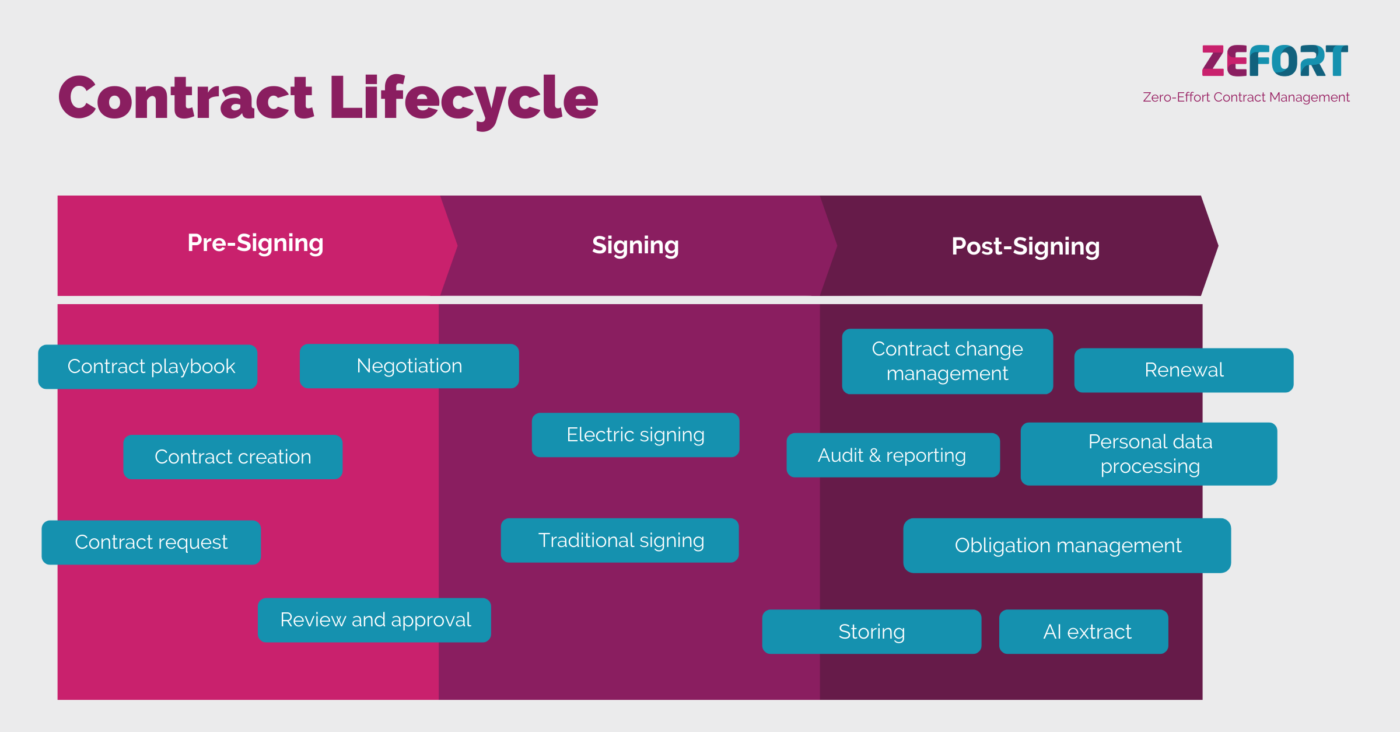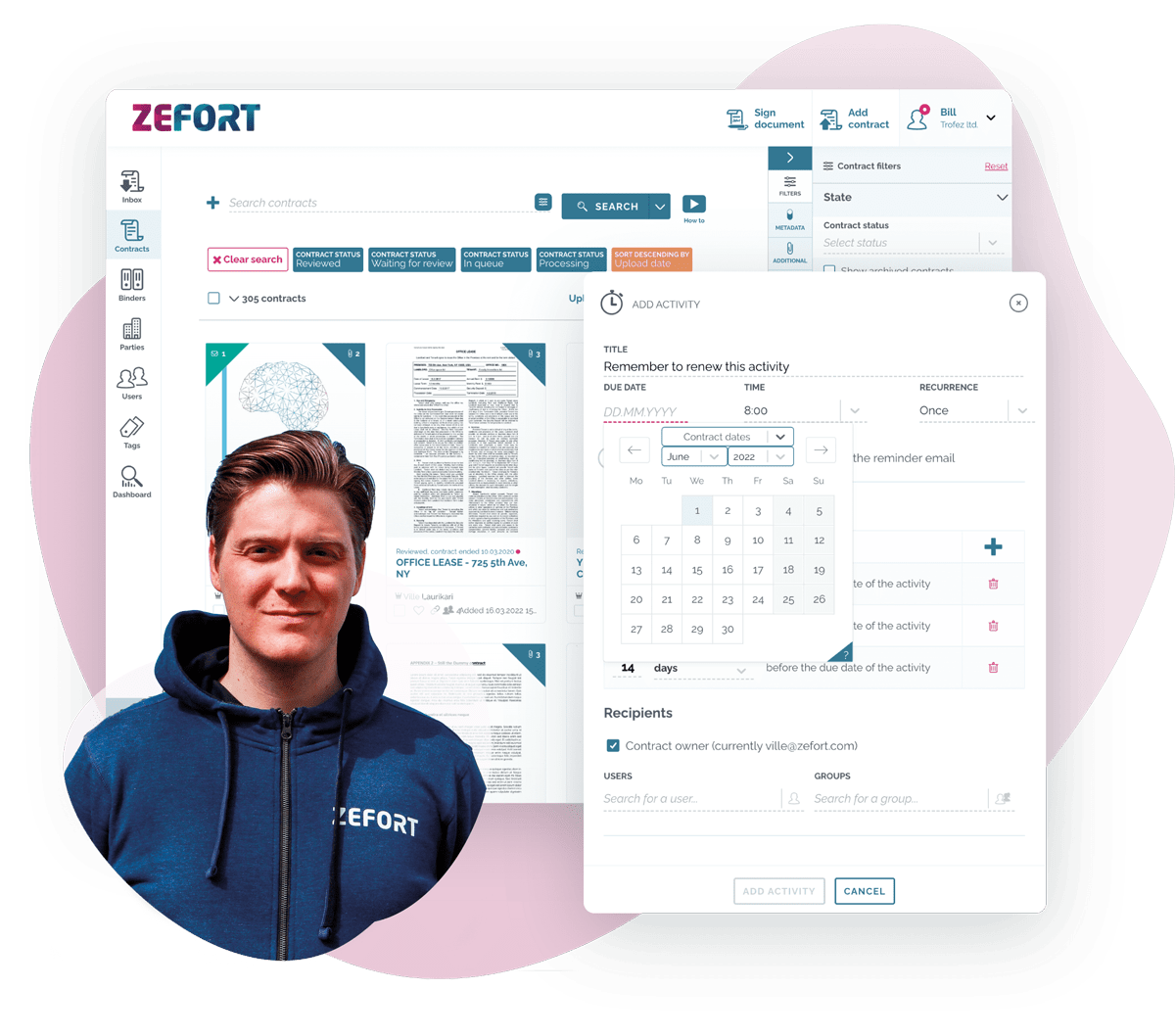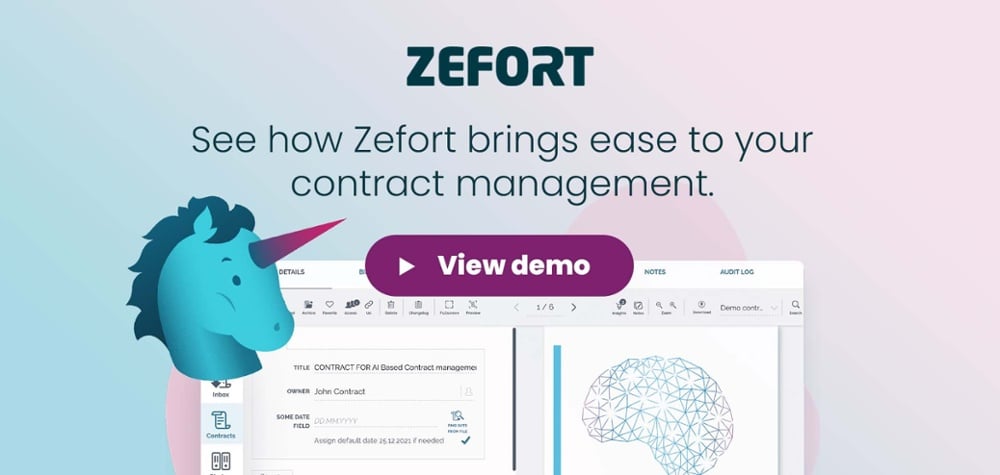How can companies get significant improvements to contract management? How can you do more with a small team? How do you get started with a digital contract management process – or update your current process to match today’s best practices?
In this article, we take an overview of what modern contract management is and how you can benefit from it. You’ll learn the three main phases of the contract lifecycle (CLM) process. No matter whether you are looking to upgrade your existing process or starting from scratch, this article will give you inspiration and information for taking the next step.
What is contract management?
Contracts are the cornerstone of business. Sales contracts open sources for company revenue, purchase and HR contracts power the company’s day-to-day operations, and so on. Contracts are everywhere and they are growing both in terms of volume and complexity.
Contract management essentially means taking control of the ways how contracts are created, executed and managed throughout their lifecycle. A good process optimizes operational performance while keeping the legal and financial risks minimal.
Contract management involves a set of agreed practices and procedures shared by the company’s team, including both legal experts and virtually anyone who deals with contracts in the organization.
Technology is an enabler of the process. Tools and software that make handling contracts throughout their lifecycle more efficient allow you to save time and money, focus on more interesting tasks, and be more confident about your company’s liabilities.
There are specific terms in the contract management landscape. For instance, sometimes contract management is called Contract Lifecycle Management or CLM. Contract Lifecycle Management essentially means having a proactive, systematic approach to managing contracts throughout their lifecycle – from start to termination or renewal and the long-term archival of the contract.
To get to know all the essential terms, we created an article: Contract Management Glossary: 28 Terms You Need to Know
Benefits of contract management
Today, contract management is far from an administrative task. Making an investment in building an efficient contract management process creates value for the entire organization.
When your contracts are managed properly, you can:
- Shorten your sales cycles
- Save both time and money
- Mitigate your legal risks better
- Boost your employee’s motivation
- Get more confidence to your work
- Control important contract deadlines
Especially in a business-to-business setting, the speed in which you close your deals often makes a difference. Making contract negotiations and the actual signing event as smooth as possible cuts down the turnaround time for striking a deal.
With proper contract management tools, you can save your experts’ time, which translates into money savings. When you let a suitable software tool do most of the routine work, such as archiving contracts, you both cut costs and increase your team’s motivation – no-one enjoys using clunky tools for repetitive tasks.
Finally, a proper contract management software helps you remember important contractual events, such as renewal dates and deadlines. This helps you meet your contractual obligations and terminate costly contracts that are no longer needed.
Why growth companies love digital contract management
Growth-hungry startup companies typically raise funding through several investment rounds and may have plans to sell the company at a fairly early stage. Having a good grip of contracts makes the due diligence work easier and negotiations with business partners faster.
The digital contract management process
Traditionally, contract management has involved a lot of manual work: emailing documents around, saving files on network drives and entering contract metadata by hand. Adopting a digital contract management process essentially means moving as much routine work to software as possible.
Supported by the right contract lifecycle management software and integrating the supporting systems together, you can increase the efficiency, accuracy and scalability of your contract management. Essentially, you can do more with less – less time, less human resources, less costs and less uncertainty.
Modern tools can boost your work in each step of the contract management process. For the purpose of this article, we have separated the process into three main phases:
- Activities that take place before the contract is signed
- The actual event of signing the contract and
- The steps after the contract has been signed.

Next, we will dig deeper into each process phase and discuss how digital tools can boost your performance at each step.
Pre-sign: Smooth collaboration is essential in contract creation
What we cannot outsource to software is human interaction and decision making. What we can do, though, is make person-to-person and team-to-team collaboration as fluent as possible and support important decisions with clear processes and up-to-date data.
From a contractual perspective, this means making all the steps leading up to actually signing the contract as easy as possible for all parties – your company’s legal team, the people handling the negotiations and, naturally, your business partner.
Contract creation with smart templates
When we think of contracts, we think of lawyers and legal professionals. However, in real life contracts are mostly utilized by others: salespeople, HR managers and IT managers, and so on. If legal experts were involved with each individual contract, it would mean a huge amount of work for the legal team and bottlenecks for the entire organization.
That’s why legal teams should focus on making the “standard” contractual processes as simple as possible for non-legal teams and instead focus on any exceptional cases that may appear.
A key enabler for efficiency is the use of contract templates. Templates can speed up the contract process while enforcing consistency and managing your liabilities.
In a digital world, an ideal contract authoring solution helps you create and manage a set of templates from which anyone can choose the right one for their needs.
For example, when a sales manager starts writing a new contract, the tool could automatically prefill the template with basic data from the company CRM and pull the standard text for a sales contract.
Moving forward, the template guides the user with a set of questions on terms that are typically different in each sales case. This way, the sales manager can simply focus on the specifics of the current deal at hand.
At the end of the day, templates can make operational teams more autonomous, speed up the work and enforce consistency – which is a cornerstone in managing your liabilities.
Interactive negotiation in the cloud
Even though you have a great contract template, changes to the contract are bound to happen when the terms are negotiated with your business partner. So, your contracts are likely to get lots of revisions before signing on the dotted line.
If your contract negotiation process involves emailing documents as attachments back and forth, you’re missing out on many benefits and making your work too hard.
Consider these challenges:
- Version control: having several people working individually with multiple document copies is bound to end up in confusion.
- Collaboration: Word files are not optimal as documents that pass through many hands. Revisions, comments, tracked changes quickly become a mess.
- Speed: When you send a file to the other contractual party, it means that you have to wait until their reply to work on it again.
- Security: When you email a file, you essentially also hand over the control on who can access the file.
An ideal, digital solution allows you to collaborate with your contractual party in real time, safely in the cloud. Today’s tools should allow collaborative editing, version control, and a rich history of changes.
Quick reviews and approvals
Especially larger companies may have defined so-called contract playbooks that set specific standard rules for contracts, such as company’s standard contract terms with fallback clauses (i.e., variations of the standard clauses that the company would accept if the customer wants to negotiate a standard clause), acceptable payment terms or internal approval processes. Your digital process should support these requirements.
For example, while working with internal stakeholders should be smooth, in practice getting all the required approvals might take days, even weeks. This causes a delay in the process, potentially causing friction between your contracting party who is eager to close the deal.
While a contract management tool cannot force a manager to hit the approve button quicker, it could make your workflow easier:
- Version control: Again, you can make sure there are no multiple copies of the contract going around.
- Reminders: The system can automatically send gentle reminders to the person whose turn it is to take action.
- Conditions: You could set up rules that deviate from the regular approval process, for example when a deal amount exceeds a certain threshold, it should be approved by a higher authority.
What’s more, a digital tool can give you transparency and traceability to your approval process. You’ll be able to see on whose table the approval is right now and you get a digital log proving that the right process has been enforced.
Signing: Digital signatures speed up your contract process
Once you have completed the negotiation and approval phases, it’s time to close the deal by signing the contract. Digital signatures have become the gold standard for this as they are simple, quick and secure.
Digital signatures are perhaps the most widely adopted legal technology tool. Compared to traditional signing, the benefits of digital signatures, or e-signatures, are clear:
- No limitations on time and space: your business partner can sign anytime, anywhere.
- Higher speed: get signatures faster, in a matter of minutes or hours instead of days or weeks.
- Ease of archival: you can set up automatic contract archival once the signatures are complete.
- Transparency: you get full visibility over the signature process.
Digitally signed contracts are as legally binding and valid as traditional signatures. Sometimes even more so: you get a digital log for tracing the signature events and exact time stamps, for example.
However, digital signatures are not (yet) a silver bullet. Depending on your local legislation, there might be contracts that simply cannot be signed digitally. For this reason, make sure that your process also supports traditionally signed contracts.
Three levels of electronic signatures
Did you know that there are different levels of digital signatures? The European Union eIDAS digital identification regulation defines three levels: basic, advanced and qualified signatures. If you are operating in EU countries and your business involves contracts with heavier ramifications, such as insurance documents, check out your country-specific requirements.
The digital signature component could be a part of your overall contract management solution or you could turn to a separate e-signature service – there are many excellent alternatives available.
When selecting a service provider, put emphasis on the integration features: how well the tool matches with your process and can you automate any steps, such as contract archival.
Post-sign: Managing your contracts after signing
What happens after you have signed that carefully negotiated contract?
Far too often, the signed contract is simply forgotten: it’s abandoned in a personal email, filed in a cabinet or saved on a network drive. The steps after the signature essentially define how well you can manage the contract in the future.
The post-sign phase is equally important to everything that preceded it: now the contract terms are fulfilled, obligations met, liabilities managed and termination or renewal events handled.
Storing contracts in a single contract repository
The starting point for all post-signature activities is having a single, centralized contract repository. Here you and everyone in your company can store all contracts, regardless of whether they are sales contracts, HR contracts, partner contracts or anything else.
When you have all your contracts in one place, you can better manage your liabilities and find the contracts you need quickly.
A good contract repository allows you to:
- Archive contracts easily, either manually or automatically via an API
- Save your experts’ manual work through automation, such as extracting key contract metadata with the help of an AI component
- Find the contracts you need quickly and easily
- Easily manage team sharing and access rights
- Also store contract-related materials, such as emails and other documents
Also pay attention to the user experience, or ease of use, of the contract archive. If it is difficult to add new contracts or entering contract metadata takes a lot of manual work, the chances are that users in your organization simply won’t do it.
AI in contract management
One of the latest technological advances is the introduction of AI, or artificial intelligence, to contract management. In contract archiving, for example, AI can mean smart software algorithms that process a contract and extract key data that is then used for automatically adding metadata, enabling smart searches or automated reminders.
Obligation management and follow-up
Once the contract is signed, the execution of its terms starts. Contracts usually come with specific responsibilities, schedules and tasks. Although you might create a separate project plan to guide your work, the source contract remains an important document that guides your work.
A modern contract management solution allows you to set up automated reminders and alerts for contract obligations or events. In practice, the person responsible for a specific task gets an email notification when it is due, for example.
Most contracts come with specific schedules and renewal or termination dates. Getting contract notifications not only helps you manage your liabilities but helps you save money, too. Consider contracts that renew automatically – when you get a timely alert, you can make a conscious decision on whether you want to renew your contract or not.
In addition, the people involved in the actual operational work might want to double check contractual details from time to time. For this purpose, your contract management system should be accessible for these users, too.
Contract change management
Contracts are bound to get changes, updates and amendments. Some might involve a completely new contract version or simply agreeing on deviations or extra tasks via an email conversation, for example.
Make sure your contract archive allows adding new contract versions, adding new attachments and archiving email conversations as together with the main contract document.
For smaller contract amendments and minor changes, it is good to have a change log that allows you to track and verify changes throughout the contract’s lifecycle.
Reporting and data management
Depending on your organization, you might be required to provide regular reports on contractual matters. A good contract archive lets you pull together the contracts you need quickly and reliably for your reporting needs.
Managing personal data in the GDPR world
EU’s GDPR legislation gives individuals the right to be forgotten, that is, having their personal information removed from a company’s archive. As a rule of thumb, you should not store personal information any longer than you are required to do so. So, take this into consideration when planning what data you are collecting and what happens to it once you are no longer allowed to store it.
A regular part of post-signature management is ensuring that the contract data remains valid and up to date. This might mean updating contractual party names of business ID’s, for example. Make sure your contract archive allows this, too.
How to get started with contract management?
So, how do you start upgrading your contract management process? If you are working in an established company, you probably already have some tools and processes in place. On the other hand, if your brand company is starting from scratch, you might have limited resources or you simply don’t know what you will need down the road.
Start by analyzing your current situation and needs. What is working and what needs improvement? Do you want to improve a specific part of the process or re-do everything? What are the strengths and weaknesses or your current workflow?
Once you know what you need, you can start looking for suitable solutions in the market. Also follow these steps to get started with contract lifecycle management software. When you find a potential service provider or partner, ask them the following questions:
How easy is it to get started? Does your solution work from the cloud or do I have to prepare for an IT project?
What are your references? What other customers have to say about your solution?
How flexible are you? Does your solution force me to change my current processes or can you adapt to my existing set up with integrations, for example?
Will you take my data hostage? How easy is it for me to move on to another solution in case you’re not the right match for us?
Is your solution easy to use? Have you paid attention to the design and user experience of your solution?
The great news about getting started with a contract management is that trying out new solutions has never been easier. Many legal tech tools work straight from the cloud and allow free trials.
So, if you’re curious about how a specific tool actually works, don’t be afraid to take it for a test drive – you’ll be wiser in just a few minutes.






